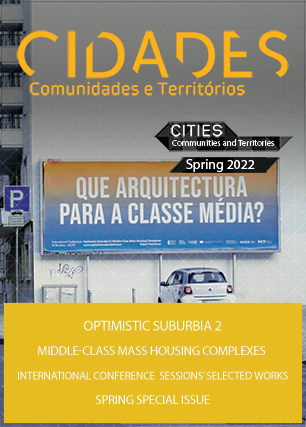Devicology: Expanding fieldwork possibilities for architectural observations in inhabited interiors
the case of Japanese post-war mass housing
Palabras clave:
Japan, social housing, postwar mass housing interiorsResumen
Japanese mass housing from the 1960s has a colloquial nickname — danchi, which can be translated as “common land.” Originally celebrated by the public as a highly desirable living environment, danchi are now becoming a source of problems for the government. After briefly introducing the reader to the history of danchi, this paper will turn to investigate the interior lives of their current residents who stay hidden from the media attention behind dilapidating concrete walls and layers of social stigma. This work will attempt to propose a practical methodology on how to collect and interpret ethnographic materials from the apartment visits in relation to factual architectural knowledge. The data collected during the visits became the most controversial part of this research: in the spotlight is the abnormal inability of danchi residents to verbally admit their unsatisfactory living conditions that arises from the Japanese cultural characteristic of gaman, roughly translated as “perseverance”. Despite dire living conditions, clearly depressed inhabitants keep repeating that they cannot imagine living a better life. Balancing on the edge between ethnography and architecture, an innovative interior analysis method named “Devicology” (in homage to Wajiro Kon’s “Modernology”) can help us look beyond these modest replies by detecting “devices” —– intricate systems of unconventionally used furniture and smaller, less permanent objects, that are unconsciously assembled by the residents. These visually chaotic yet surprisingly functional structures are the only tool of the current dwellers to negotiate with the restricting standard apartment plans that were originally designed for a very different sector of the Japanese population. Beginning as an examination of behaviour patterns in a single apartment, Devicology has the potential to become a study of the collective unconsciousness of different people stuck in the same conditions with the same set of rules.
Citas
Akasegawa, G. Fujimori, T., & Minami, S. (1986). Rojō kansatsugaku nyūmon. Tokyo: Chikuma shōbō.
Aterlier Bow-Wow. (2002). Pet Architecture Guide Book. World Photo Press.
Bricocoli, M., Postiglione, G., & Sabatinelli, S. (2019). Re.Co.De: Reshaping contemporary dwelling. In D. Wu S. Pedigo et Al. (Eds.), Affordable Housing (pp. 156–161). London: Archive Books.
Bricocoli, M., Sabatinelli S., & Postiglione, G. (2020). Il progetto dell’abitare alla prova delle pratiche. In G. Cafiero et Al. (Eds.), Costruire L’Abitare Contemporaneo (pp. 254–258). Padova: Il Poligrafo.
Caramellino, G., & De Pieri, F. (2019). The emergence of the micro scale in historical research on modern housing. In A. Kockelkorn & N. Zschocke (Eds.), Productive Universals Specific Situations (pp. 295–313). Sternberg Press.
Daniell, T. (2012). Just Looking: The Origins of the Street Observation Society. In T. Fujimori et al., Terunobu Fujimori: Architect (pp. 210–221). Ostfildern: Hatje Cantz.
Daniels, I. (2010). The Japanese House: Material Culture in the Modern Home. Oxford: Berg.
Hara, T. (2012). Danchi no kūkan seiji-gaku. NHK Publishing.
Hirayama, Y. (2007). “Reshaping the housing system: home ownership as a catalyst for social transformation.” In Y. Hirayama, & R. Ronald (Eds.), Housing and Social Transition in Japan (pp.15–47). New York: Routledge.
Izuhara, M. (2000). Change and Housing in Post-War Japanese Society: The Experiences of Older Women. London: Routledge.
Kinoshita, Y., Watanabe M., Iseki K., & Liger, J. (2019). Danchiryoku no katsuyō ni yoru danchi saisei hōhō no jissentekina kenkyū. Jusoken: Journal of the Housing Research Foundation, 45, 209–218.
Knoroz, T. (2020). The Rise and Fall of Danchi, Japan’s Largest Social Housing Experiment. ArchDaily, February 19, 2020. https://www.archdaily.com/933829/the-rise-and-fall-of-danchi-japans-largest-social-housing-experiment.
Kon, W., & Yoshida, K. (1930). Modernologio (Kogengaku). Shun-yodo.
Kaijima, M., Kuroda J. & Tsukamoto, Y. (2001). Maido in tōkyō (Made in Tokyo). Tokyo: Kajimashuppankai.
Moeran, B. (1984). Individual, group and Seishin: Japan’s internal cultural debate. Man, 19(2), 252–266.
Murakami, S. (2018). Danchi Highlight Complexity of Japan’s Interculturalism. The Japan Times, September 18, 2018. https://features.japantimes.co.jp/danchi/.
Nietzel, L. (2016). The Life We Longed For: Danchi Housing and the Middle Class Dream in Post-war Japan. Chicago: MerwinAsia.
Nishiyama, U. (1989). Sumai Kōkongaku: Gendai Nihon Jūtakushi (2nd edition). Shōkokusha.
Ōshima, T. (2018). Shibaen danchi ni sundeimasu kisha ga jūmin to shite mita shizukana bundan to kyōsei. Asahi Shimbun, June 1. https://globe.asahi.com/article/11578981.
Shinozawa, K., & Yoshinaga, K. (2017). Danch izukai chikei zōseirando sukēpu jū-tō madori kara yomitoku sekkei shikō. Gakugei shuppansha.
Uchida, S. (2002). Kieta modan tōkyō. Kawade shobōshinsha.
Waswo, A. (2002). Housing in Post-war Japan – A Social History. New York: Routledge.
Yasuda, A. (2002). Kōdan chintai seikatsu. 10+1, 26, 85–101.
Yasuda, A., & Nobuaki, F. (2000). Kōdan jūtaku kyojūsha no seikatsu sutairu ni kansuru kenkyū. Summaries of Technical Papers of Annual Meeting of Architectural Institute of Japan - 2000, 99–100.
Yasuda, K. (2019). Immigration and Aging in Japan’s Public Housing Projects. Nippon, August 8. https://www.nippon.com/en/in-depth/d00502/immigration-and-aging-in-japan’s-public-housing-projects.html.
Descargas
Publicado
Número
Sección
Licencia
Derechos de autor 2022 Tatiana Knoroz

Esta obra está bajo una licencia internacional Creative Commons Atribución-NoComercial-SinDerivadas 4.0.
Cidades, Comunidades e Territórios by DINÂMIA'CET-IUL is licensed under a Creative Commons Atribuição-Uso Não-Comercial-Proibição de realização de Obras Derivadas 4.0 Unported License.Permissions beyond the scope of this license may be available at mailto:cidades.dinamiacet@iscte.pt.






